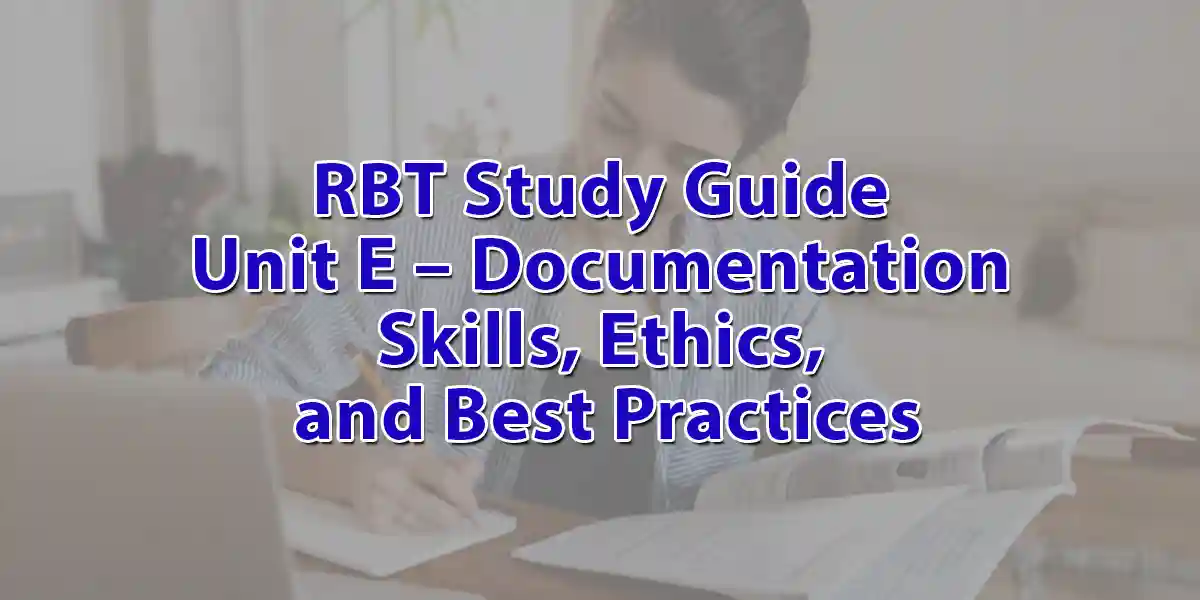Documentation is the backbone of effective Applied Behavior Analysis (ABA) services. As a Registered Behavior Technician (RBT), accurate, timely, and ethical documentation ensures that supervisors can make informed decisions, track progress, ensure client safety, and maintain compliance with ethical and legal standards. Unit E: Documentation from the RBT Task List provides the structure for mastering these responsibilities.
Whether you’re recording session data, writing progress notes, or completing incident reports, everything you document plays a role in your client’s development and the clinical team’s success. This guide explores the key concepts of Unit E in depth and ties them to Units A through F of the RBT Task List. It also reinforces how RBT Practice Exams 1, 2, 3, 4, and 5 support mastery of this essential unit.
Why Documentation Matters in ABA
Documentation isn’t just a technical task; it’s a professional obligation. Every action you take as an RBT should be traceable, measurable, and reviewed. Your documentation helps.
- Track progress toward goals
- Monitor the effectiveness of behavior intervention plans
- Record occurrences of challenging behavior or critical incidents
- Inform insurance billing and legal compliance
- Maintain continuity across providers and sessions
- Demonstrate ethical, client-centered care
Incorrect or missing documentation can delay treatment, result in legal issues, and even compromise client safety. That’s why Unit E holds equal importance to technical skills covered in Unit A: Measurement and Unit C: Skill Acquisition.
Types of Documentation Required by RBTs
An RBT is responsible for several forms of documentation. Let’s explore each one and its purpose:
1. Session Notes
These are daily records of what occurred during your session. They summarize the client’s performance, what programs were run, how they responded, and any relevant behavior or events.
Example:
“Client completed 4 of 5 targets for brushing teeth independently. The second step necessitated the use of gestural prompts. During the transition, the individual vocally protested and was then redirected using their preferred toy. Data entered into the central system.”
Good session notes are
- Objective (avoid opinions or assumptions)
- Concise but detailed
- Written immediately after the session
2. Data Sheets
These record trial-by-trial or summary performance data and tie directly to the teaching targets listed in the skill acquisition plan or behavior intervention plan.
For example, while working on manding, you may log each prompted and independent request and reinforcement used.
These sheets reflect content from Unit C: Skill Acquisition and Unit D: Behavior Reduction, as well as technical procedures covered in RBT Practice Exams 2 and 3.
3. Incident Reports
These are completed when a significant or unexpected event occurs, such as aggression, elopement, or injury. These reports include who was involved, what happened, how it was handled, and any follow-up needed.
Documentation here must follow protocols set by the supervisor and organization.
RBT Practice Exam 4 provides incident scenarios that help you refine your crisis documentation skills.
Principles of Good Documentation
There are four core principles every RBT should follow when documenting:
1. Accuracy
Document exactly what you observed, not what you inferred. Avoid vague terms like “bad behavior” or “seemed upset.” Instead, write what happened:
“Client dropped to the floor, screamed for 2 minutes, and hit the floor with an open hand.”
This principle supports Unit A: Measurement, where data precision is key.
2. Timeliness
Write your notes as soon as the session ends. Waiting until later increases the chance of forgetting key details or making errors. Many agencies require documentation within 24 hours.
3. Objectivity
Stick to facts. Don’t include assumptions, diagnoses, or personal opinions.
Avoid: “Client faked crying.”
Instead: “Client began to cry without visible tears after being denied access to iPad.”
Unit F: Professional Conduct reminds us that respectful, unbiased documentation is part of our ethical duty.
4. Confidentiality
All notes must be written and stored according to HIPAA and organizational guidelines. Never share client names or identifying info outside of the authorized team.
These principles are embedded in many of the questions you’ll find in RBT Practice Exams 1 and 5, where your understanding of ethical and legal documentation is tested.
Linking Documentation to the Other RBT Units
Every part of the RBT Task List connects with documentation:
- Unit A: Measurement – You’ll document behavior frequency, duration, and other dimensions using data sheets.
- Unit B: Assessment – When supporting assessments like preference or functional behavior assessments, you’ll record results and observations.
- Unit C: Skill Acquisition – You’ll track progress toward skill goals, log prompt levels, and reinforce procedures.
- Unit D: Behavior Reduction – You’ll log ABC data, crisis events, and implementation of consequence strategies.
- Unit F: Professional Conduct – You must document with integrity, confidentiality, and accuracy, as this reflects your professionalism.
Understanding how documentation serves each of these domains helps build consistency in your role and helps you avoid critical errors.
Common Documentation Mistakes (and How to Avoid Them)
- Being too vague
Avoid phrases like “Client was fine” or “Session went well.” These lack meaningful detail. Instead, document specific behaviors and outcomes. - Using subjective language
Don’t write assumptions like “Client was mad for no reason.” Focus on behavior: “Client raised voice and stomped feet after being told to clean up.” - Skipping important information
Always include relevant data—even if the session was interrupted or the client didn’t engage. - Delaying notes
The longer you wait to write, the more likely details will be forgotten. Build documentation time into your daily schedule. - Poor grammar or spelling
Your documentation may be reviewed by supervisors, insurance companies, or even legal authorities. Write professionally.
These issues are reflected in various question types throughout RBT Practice Exams 2–5, helping you prepare for real-world expectations.
How to Write Great Session Notes
Every ABA agency has its preferred format, but here’s a proven framework to follow:
- What goals were targeted?
Include skill acquisition and behavior reduction goals. - How did the client respond?
Mention prompt levels, independent responses, and behavior data. - What interventions were used?
Specify if you used differential reinforcement, extinction, etc. - Any significant events?
Describe relevant behavior, environmental changes, or medical concerns. - Plans for the next session
State whether goals will continue, be modified, or mastered.
Example Note:
“Today, the client worked on handwashing and initiating peer greetings. Required 2 verbal prompts for 4 out of 5 steps in handwashing. Spontaneously greeted a peer once. Engaged in task refusal (crossed arms, verbal protest) during transition. Used visual schedule and first-then board to re-engage. No incidents. Next session will continue current goals.”
You can practice refining your documentation style with mock templates and case studies—many of which are simulated in RBT Practice Exam 3.
Crisis Documentation and Reporting
RBTs must document any behavioral incidents that result in injury, property destruction, physical intervention, or deviation from the plan. This documentation must include:
- Antecedents – What happened before the event?
- Behavior – What did the client do?
- Response – How did the staff respond?
- Outcome – What was the result?
You should also report:
- Who witnessed the event
- Duration and severity
- Whether parents/caregivers were notified
- Any follow-up steps taken
Crisis documentation is often reviewed by clinical teams and administrators and may become part of insurance audits or legal proceedings. That’s why it must be factual, complete, and professionally written.
Unit D: Behavior Reduction prepares you for these situations behaviorally, while Unit F: Professional Conduct guides your ethical response.
RBT Practice Exam 4 features scenarios that test your ability to write clear, accurate reports for behavioral incidents.
Digital Tools and Software for Documentation
Most ABA organizations use electronic health record (EHR) systems or software like:
- Catalyst
- CentralReach
- Rethink
- AccuPoint
- Therap
These platforms include:
- Digital data sheets
- Session note templates
- Built-in timers and graphing tools
- Secure communication portals
Learning to navigate these tools is essential for modern RBTs. Always log out when not using them, and avoid accessing systems on personal or public devices without authorization.
Digital documentation still requires the same accuracy, ethics, and professionalism as paper-based systems.
Feedback and Documentation Review
RBTs receive regular feedback on their documentation from BCBAs or supervisors. Feedback may focus on:
- Clarity and grammar
- Completeness and detail
- Professional tone
- Accuracy in reporting prompt levels or procedures
- Legal and ethical compliance
Use this feedback as an opportunity to grow. Take notes, ask questions, and apply changes consistently.
As you develop your skills, your documentation will become a reliable source of truth that helps the whole team support the client more effectively.
Conclusion: Documentation Is a Clinical Skill
Unit E: Documentation is more than just writing down what happened—it’s a clinical skill that requires objectivity, attention to detail, and professionalism. Your documentation helps guide clinical decisions, track client progress, ensure ethical care, and maintain compliance with policies and regulations.
Throughout this guide, you’ve learned how documentation connects with
- Unit A: Measurement – For tracking behavior and skill data
- Unit B: Assessment – When gathering information to build treatment plans
- Unit C: Skill Acquisition – To show growth and goal completion
- Unit D: Behavior Reduction – To record strategies, outcomes, and crises
- Unit F: Professional Conduct – To uphold dignity, ethics, and legal responsibility
To prepare for your RBT exam, continue practicing with:
- RBT Practice Exam 1 for session note formats and objective writing
- RBT Practice Exam 2 for data integrity and report accuracy
- RBT Practice Exam 3 for measurement-linked documentation
- RBT Practice Exam 4 for crisis and incident reporting
- RBT Practice Exam 5 for integrating documentation with ethical practice
As an RBT, the way you document is a reflection of how seriously you take your role. Master this skill—and you’ll become a trusted and essential member of your ABA team.

